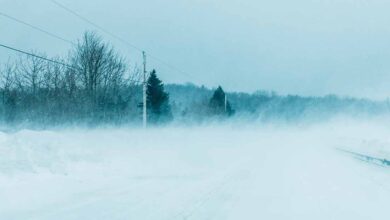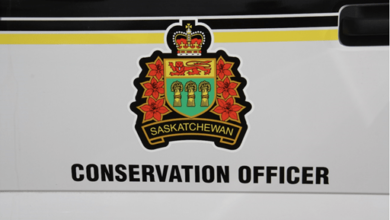
AgricultureNews
Insect Surveys in Saskatchewan
By James Tansey, PhD AAg, Provincial Insect/Pest Management Specialist, Regina

To get a sense of the potential threats to Saskatchewan crop production that insect pests pose, we need to evaluate their populations. The Ministry of Agriculture, in collaboration with Saskatchewan Crop Insurance Corporation (SCIC), Agriculture and Agri-Food Canada (AAFC), the University of Saskatchewan, and other volunteers and contractors, determines the regional population levels and timing of arrival of several serious pests of important crops in the province. Results of these surveys contribute to annual forecast maps and timely updates to ministry webpages and to the Prairie Pest Monitoring Network. These results inform research priorities, scouting and grower seed purchase decisions, and contribute to regulatory efforts. The surveys include a variety of pests in the following crops.
Canola and mustard
- Diamondback moth, Plutella xylostella: This insect is pushed along by high-altitude winds from the southeastern United States and Pacific Northwest, as well as northern Mexico in the spring and early summer. All crop stages are vulnerable to larval feeding. Young larvae mine leaves, and more mature larvae can cause shot-hole damage, can skeletonize leaves and strip pods. We monitor this insect with a network of approximately 40 sentry sites, equipped with sex-pheromone-baited traps. These traps allow us a broad assessment of local pressures and the timing of arrival. The earlier the arrival, the greater potential for population increase.
- Cabbage seedpod weevil, Ceutorhynchus obstrictus: This invasive insect is a serious pest of canola. Adults feed on developing flowers and can cause bud blast. Females lay eggs in developing pods; larvae consume seeds as they grow. Both the entry holes chewed by the females to insert eggs and the exit holes chewed by mature larvae as they emerge from pods can be avenues for disease. Yield and quality can be affected. We monitor this insect annually with in-field sweep samples throughout the province. Results allow us to determine local pressures and spread of the invasion.
- Bertha armyworm, Mamestra configurata: This native insect overwinters as a pupa and is monitored with a network of approximately 250 pheromone traps. Larvae can be very damaging to foliage and pods. Results of trap catches allow us to determine rough local pressures and the timing of peak emergence. Scouting of individual sites should begin two weeks after peak emergence. This insect has also shown an affinity for quinoa.
- Swede midge, Contarinia nasturtii: These insects have not yet been detected in Saskatchewan, but, because of the potential threat and their presence in other parts of Canada, we continue to monitor with pheromone traps. Larvae of these little flies cause distorted growth in canola and can affect yields.
Pulses
- Pea leaf weevil, Sitona lineatus in peas: This is another invasive insect, and can cause significant yield losses to peas and faba. Although adults can cause damage by feeding on foliage, most yield reduction is associated with larval feeding within Rhizobium nodules. We survey this pest by examining the feeding damage associated with adults in fields throughout the province. This survey allows assessment of local pressures and spread of this insect.
- Lygus spp.: These native insects can be serious pests of faba both as juveniles and adults. Piercing-sucking feeding by these insects can result in significant yield and quality reductions. Sampling in 20 fields throughout faba bean growing areas (primarily cropping districts 9, 8, 6A, and 5) are conducted during early August.
Small grains cereals
- Wheat midge, Sitodiplosis mosellana: Larvae are this insect’s damaging stage and can have a serious impact on yield and quality. Eggs are laid from late June to early July on the plant’s developing heads. Adults are short-lived (usually less than a week) and delicate. Dry conditions do not favour their development in the spring; they require 25 mm of rain by the end of May for good emergence. There are midge-tolerant wheat varieties available as varietal blends (VB). For 2020, VBs are available in CWRS, CPSR, CWSP, CWSWS, CNHR, CWES and Durum wheat classes. Surveys for these insects occur in the fall in-field throughout the wheat-growing regions of the province.
Fruit pests
- Spotted wing Drosophila, Drosophila suzukii: This invasive insect was first detected in Saskatchewan by the ministry in 2019. Females have saw-like ovipositors that they use to penetrate ripening fruit. Eggs are laid and the developing larvae feed inside fruit, resulting in unmarketable product. This insect has a very broad host range and has been documented feeding on raspberry, strawberry, cherry, blueberry, plum and Saskatoon berry. Haskap is also considered susceptible but may escape major damage, as spotted wing Drosophila populations typically do not increase until after harvest. The ministry will continue to monitor this insect in 2020 with pheromone traps.
Generalist pests
- Grasshoppers: Although we have 85 species of grasshoppers in the province, only about five of them are damaging. A good rule of thumb is “if it has wings in the spring, it’s not a pest.” For pest species, host preferences include cereals, flax, and lentils and other pulses. Canola is less preferred by these animals and soybean can take a lot of foliar feeding before yield is influenced. Typically, thresholds for these species is 10 to 12 per square metre, but in lentil and flax, thresholds are reduced to two per square metre. SCIC conducts a province-wide survey of grasshopper populations in the late summer and records site-specific hopper counts.
For the latest information and for more updates on everything Kindersley ‘Like’ the Kindersley Social Facebook page below…








































